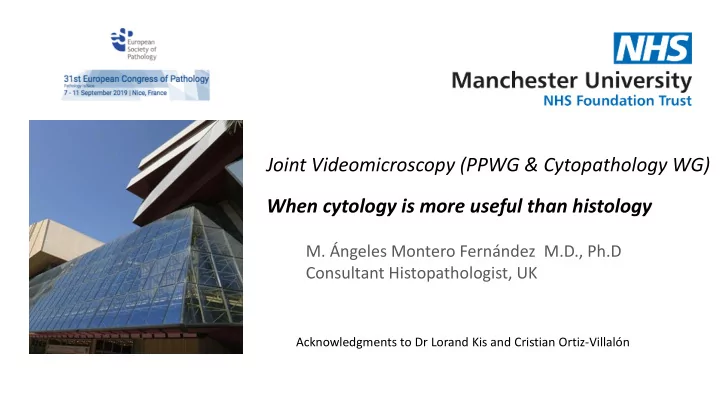

Joint Videomicroscopy (PPWG & Cytopathology WG) When cytology is more useful than histology M. Ángeles Montero Fernández M.D., Ph.D Consultant Histopathologist, UK Acknowledgments to Dr Lorand Kis and Cristian Ortiz-Villalón
Clinical history: referral case • 27 yrs old male. • 12 th Dec : bilateral otitis media treated with fenoximetilpenicillin. Later developed dyspnea and cough. • 7 th Jan (1st visit to GP) : diagnosis of pneumonia, treated accordingly with penicillin with no improvement. • CT thorax-abdomen: bilateral lung infiltrates. Needed O2 therapy (3L in rest) • Switched to Amoxicillin- developed skin rush. • 18th Jan : bronchoscopy – BAL negative for fungi; influenza A,B, RS virus negative. no blood eosinophilia; negative for ANA, ANCA, Ig, CCP, RF • Treatment: Steroids (50 mg) -- improvement • Core biopsy (25 th Jan) • Cryobiopsy right lower lobe segment 8-9 (6 th Feb) • Wedge (21 st May)
1. Core biopsy 40x bronchiole 10x
Diagnosis Chronic inflammation with focal post-obstructive features. No granuloma or malignancy seen 40x
2. Cryobiopsy 10x 4x 20x
Diagnosis Interstitial inflammation with patchy areas of organising pneumonia and alveolar macrophages. No granuloma or malignancy seen.
3. Wedge resection
2x 4x 10x
60x
60x
4x
CD68 CD56 CD30 CD163 The molecular analysis for TCR-beta CD20 MNF and TCR – gamma show evidence of polyclonal T cell population CD8 CD3 CD4 CD2 CD5 CD7
When cytology is more useful than histology? Clinical history: In the initial work-out a bronchoscopy was done: BAL negative for fungi; influenza A,B and RS virus. No differential cell count done.
Bronchoscopy procedure (briefly) Flexible bronchoscope is placed in the selected segment. Normal saline at room temp is instilled with a total volume 100 to 300 ml and divided into 3 to 5 aliquots. Minimal total volume retrieved >5 % of the instilled volume (optimal >30%). Minimal volume for the analysis 5 ml (optimal 10 to 20ml) If it is increasingly bloody: diffuse alveolar damage Gross appearance of the fluid: Cloudy with floculent material that settles in the bottom after 15 to 20 min: PAP.
Diagnosis Features consistent with chronic eosinophilic pneumonia
Pulmonary eosinophilia • Infection causes • Non-infections causes • Parasites • ABPA • Drug reaction: Nitrofurantoin and antibiotics • Chronic eosinophilic pneumonia • Acute eosinophilic pneumonia • EGPA • HES (Hypereosinophilic Synd) Clinical Microbiology Reviews 2012
Clinical history: referral case • 27 yrs old male. • 12 th Dec : bilateral otitis media treated with fenoximetilpenicillin. Later developed dyspnea and cough. • 7 th Jan (1st visit to GP) : diagnosis of pneumonia, treated accordingly with penicillin with no improvement. • CT thorax-abdomen: bilateral lung infiltrates. Needed O2 therapy (3L in rest) • Switched to Amoxicillin- developed skin rush. • 18th Jan : bronchoscopy – BAL negative for fungi; influenza A,B, RS virus negative. no blood eosinophilia; negative for ANA, ANCA, Ig, CCP, RF • Treatment: Steroids (50 mg) -- improvement • Core biopsy (25 th Jan) • Cryobiopsy right lower lobe segment 8-9 (6 th Feb) • Wedge (21 st May)
Chronic eosinophilic pneumonia: Idiopathic condition. Described in 9 patients with dyspnea, cough and pulmonary infiltrates in the radiology and eosinophils in the lung parenchyma. Mild to moderate respiratory distress for more than two weeks. Previous asthma or atopic conditions. Non-smokers. Good response to steroids Acute eosinophilic pneumonia is related to smoke exposure. No atopic or asthma. Severe respiratory distress
Take home message Eosinophilic count in the BAL over 25% is virtually diagnostic of acute and chronic eosinophilic pneumonia.
Recommend
More recommend